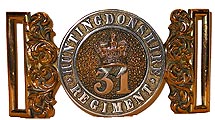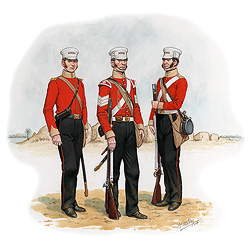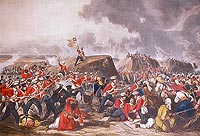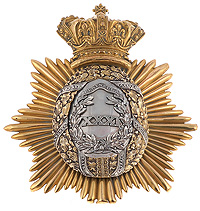 31st, First Afghan War, First Sikh War 1845-1846, The Crimean War 1854-1856
31st, First Afghan War, First Sikh War 1845-1846, The Crimean War 1854-1856
The 31st Regiment in the First Afghan War, 1839-1842
In November 1826, the 31st were ordered to Meerut, a distance of 1,000 miles. After 67 days on the road, the Regiment marched in to Meerut on 13th January 1827. More changes of station, accompanied by long marches followed. In their first fourteen years in India, in which there had been no military operations, the 31st Regiment lost 14 officers and 677 men due to sickness.
 |
| (Enlarge image) |
In December 1838, an expedition was sent to Afghanistan, and Kabul and Kandahar were captured. After two years, the British general commanding the Kabul garrison agreed with the Afghans to withdraw, but during the retirement the entire British force was massacred. This disaster had to be avenged, and a force which included the 31st was sent up from India. The punitive expedition moved from Peshawar, up the valley of the Kabul River to relieve Jellalabad and entered Kabul on 15th September 1842. The flank companies of the 31st were assigned to the garrison of the citadel of Kabul and four companies took part in the destruction of the Grand Bazaar. On 12th October the Army set out on the return march to India. This was extremely dangerous and arduous, and the 31st eventually arrived at Ambala in the Punjab in December.
The 31st Regiment in the First Sikh War, 1845-1846
The 31st were well placed for their next campaign, Ambala being some 90 miles south of the River Sutlej. In December 1845, the well armed and well trained Sikh army of about 40,000 men crossed the Sutlej and threatened the British garrisons at Ferozepore and Ludhiana. An exhausting march of 120 miles brought the 31st to Moodkee where they had their first battle with the Sikhs. Losses were heavy on both sides, but the enemy was finally driven back. Three days later, the second of the four battles of the war was fought at Ferozeshah. Described in a contemporary account as ‘the most bloody and obstinate ever fought’, the battle raged over two days. The men were exhausted for want of rest and food, but again the Sikhs were beaten. In these two battles, the strength of the Regiment was reduced to 327.
 |
| The Sutlej Campaign .(Enlarge Image) |
More savage fighting was to follow. The Sikhs were a warlike race, well armed and supported by artillery and cavalry, and they were prepared to fight to the death. A month later, at the Battle of Aliwal, the 31st stormed the village at the point of the bayonet, and captured the guns defending it. In this action, a Sikh standard was captured by the 31st. Finally, when the whole British and Indian Army had been concentrated, it was decided to attack the Sikh bridgehead at Sobraon on the south bank of the River Sutlej. This position was defended by three rows of high earthworks, supported by heavy artillery. The battle opened at dawn on 10th February 1846, and the first assaults on the ramparts were repulsed. Where the British had attacked on the right of the line, the Sikhs rushed down from their ramparts to butcher the wounded with the sword. There could have been no stronger inducement for a further attack.
 |
| Sobraon. (Enlarge image) |
The enemy artillery too was very active, and while the Regiment was reforming, both officers carrying the Colours were killed. The Queen’s Colour, its pike shattered, was raised by Lieutenant Noel, whose portrait may be seen in the Regimental Museum. At the same time, the buff Regimental Colour was seized by Sgt Bernard McCabe. Rushing forward under a withering fire, he raised it upon one of the towers of the enemy entrenchments and waved it defiantly above the enemy. The 31st swarmed forward cheering, and after two hours savage hand to hand fighting the Sikhs were driven back across the Sutlej with heavy losses. There is a contemporary engraving showing Sgt McCabe on the ramparts as the Regiment came forward in the Regimental Museum. The battle honours awarded for this campaign were Moodkee, Ferozeshah, Aliwal and Sobraon, but Sobraon holds a special place, and is still celebrated as a great Regimental occasion, especially by the 1st Bn The Queen’s Regiment. The memory of Sgt McCabe’s Heroism belongs traditionally to the Sergeants Mess, who, on 10th February each year, ceremonially become custodians of the Colours for the day. The 31st Regiment Memorial for the Sutlej Campaign and the remains of the Colours are in Canterbury Cathedral, near the present Queen’s Regimental Headquarters. Canterbury was the location of the depot of the 31st Regiment in the early l9th Century.
 |
| (Enlarge Image) |
The 31st Regiment in the Crimean War, 1854-1856
After a few years at home, the 31st were posted to Corfu in 1853, and in that year Britain and France declared war on Russia. The Allies landed in the Crimea in September 1854 with the intention of destroying the great fortress of Sebastopol in the Black Sea. The 31st did not arrive in the theatre of operations until May 1855, and first saw action in the unsuccessful attack on Sebastopol in June. During the siege that followed, the Regiment was engaged in trench warfare with occasional raids and skirmishes. The second assault on Sebastopol was delivered on 8th September 1855, and the Russians abandoned the fortress. It was the fall of Sebastopol that ended the war. Battle casualties of the 31st were comparatively light - less than a hundred~ but they lost a large number of men from disease.
Related
